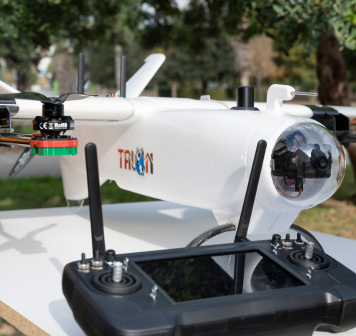2024 Landing and takeoff system for unmanned aircraft on moving surfaces
Unmanned aerial unit for vertical takeoff and landing (VTOL) with high performance and capabilities, specifically adapted for operations on mobile platforms in the maritime sector. It is easy to implement on any existing VTOL unmanned aircraft on the market and is designed to be cost-effective.
TRL 5-6: Prototype validated in experimental and demonstration environments.

S'ha desenvolupat una unitat aèria no tripulada d'enlairament i aterratge vertical d'altes prestacions i capacitats adaptades a operacions en plataformes mòbils del sector marítim, de fàcil implementació en qualsevol aeronau no tripulada VTOL existent en el mercat i a baix cost.
Technology Description
The developed system enables any vertical takeoff unmanned aerial unit (VTOL) available on the market to be operated from a moving platform.
Using open-source hardware and software, constant communication between the control station on the mobile surface and the aircraft is ensured, allowing the drone to return to its base regardless of the distance. The system incorporates a control station for receiving all operational data through flight monitoring and real-time camera imaging.
The unmanned aerial unit can operate autonomously or be remotely controlled by a pilot. Modifications or updates can be made at any time during the flight through the ground station.
The Problem
The use of unmanned aerial vehicles (UAVs) is rapidly growing globally, alongside their industrial development for civil and commercial applications. However, in scenarios where these systems must operate from moving platforms, current commercial systems face several shortcomings:
- Market UAVs use closed proprietary codes, requiring highly skilled personnel for precise operations.
- Fixed-wing platforms require catapults for takeoff and nets for landing.
- Rotary-wing platforms, whether mono- or multi-rotor, typically larger in size, demand more preparation time for operation.
Potential Advantages
- Open-source autopilot and firmware aircraft.
- Hybrid platform combining fixed-wing and rotary configurations.
- Significantly reduced preparation time for mobile platform operations, thanks to a real-time positioning beacon.
- Increased operational capability and higher cruising speed.
- Lower operational and maintenance costs.
- Compatible with commercial products, enabling seamless integration.
- VTOL vertical takeoff and landing capabilities without requiring specialized surface equipment.
Collaboration Objectives
The research group is seeking public and/or private companies and institutions in the maritime sector, particularly those involved in environmental monitoring or maritime-fishing activities. The goal is to advance prototype development and validate it in a real-world operational environment.
In collaboration with:

